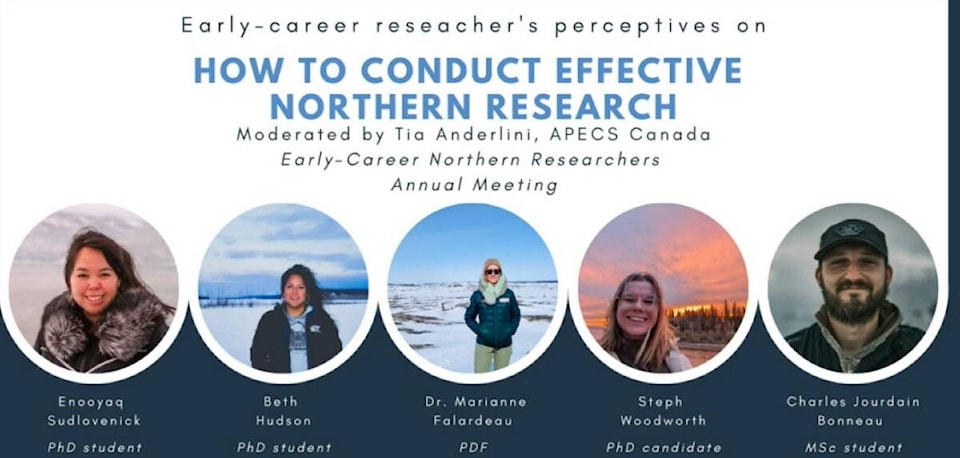At the Arcticnet convention in December, one forum revolved around the question of “how to conduct respectful and reciprocal Northern research.”
A 2018 study by Dr. Marianne Falardeau and Dr. Gwyneth MacMillan, of the University of Laval in Quebec, asked 44 early career researchers how much training they received before arriving in the field in the North, in terms of collaborative research, Indigenous perspective or ways of knowing. Among the respondents, 63 per cent said they had no training at all on the subject while 19 per cent said they had very little training.
When asked if the training should improve for future research teams, respondents voted 97 per cent in favour of increasing Indigenous perspective training.
Scientists at the forum expressed that it’s not only cultural training that’s lacking, on many occasions, research teams are sent to sites with little experience working with the technology necessary to conduct their studies.
Charles Jourdain Bonneau, a master’s student at the University of Rimouski in Quebec, says “there was a lot of technology in the lab that we had to learn by ourselves when I went up to Grise Fiord, Nunavut. It’s hard to offer specific training courses through the curriculum of every university, so we had to book them and do them on our own on the weekends before going up. Courses such as quad driving, CPR, drone flying, gun handling, working with communities, etc. would be great for a better use of our time researching in the North.”
Falardeau adds that researchers should be more connected to scientific leaders in the communities.
“When I first went up to work in the North, I had no experience working in the Inuit context in particular. There is not a lot of training to prepare you for that,” she says.
Together, the scientists concluded that sometimes field work is the best training to understand how to better work in a specific cultural environment such as Nunavut.
Enooyaq Sudlovenick, a PhD student at University of Manitoba, who was born and raised in Iqaluit, explains that researchers’ expectations can sometimes lead to confusion. Resources, especially in terms of workforce and social services, are usually not as available as down south.
“If you’re a southerner coming up to the North, understand that there is not a lot of capacity all the time at the different HTOs. Be patient and open to humour,” Sudlovenick recommends.
Balancing time constraints
Another challenge inexperienced researchers face when conducting studies in the North is trying to balance academic work for their universities with meaningful work towards the betterment of the communities.
“Sometimes taking time is hard due to some academic requirements of a degree. I think we could make system changes to improve the situation,” says Falardeau. “I think the short time frame of a master’s and PhD makes it hard to push forward some outputs that are more meaningful for communities. For example, we could have a few chapters in our thesis that are things academics want to see but then also have other chapters that are a movie or a portfolio of engagements in the community.”
An example of alternative university programs that include community-oriented goals is the Public Scholars Initiative (PSI). Launched in 2015 by the University of British Columbia (UBC), the program’s goal was to help doctoral students whose research extends beyond the academy, and beyond traditional disciplinary approaches, to have a tangible impact for the public good through collaborative, action-oriented, and/or creative forms of scholarship in their dissertation work.
“I think we should take inspiration from these kinds of programs and change how we produce research to be more inclusive of other ways of sharing research,” Falardeau says of UBC’s program.
Better guidance for new researchers around the lab and in the communities upon arrival is what Sudlovenick would implement to better the research process.
“Making new grad students feel welcome; making a special effort to make sure they know what and where everything is; making an effort so they know everyone on their floor or in the lab and the rest of the community really makes a difference. At the end of the day we’re all supporting each other,” says Sudlovenick.
The scientific community needs to connect more, to learn from each other, she continues.
“Networking to find out what people do — everyone’s research is very specific but the approaches are often very similar,” she says.
Although the language barrier can be a challenge for some, there are resources and key individuals who are there to help.
“My first language is Inuktitut but even for me, going to different regions of Nunavut, like Arviat, there is a different dialect, so I had to find a translator because I couldn’t understand the Elders I had to interview,” says Sudlovenick. “There are translators available across Nunavut. Learning some basic Inuktitut or Inuinnaqtun or Inuvialuktun words also goes a long way to show you care. There are now mobile applications available to learn the languages too.”
